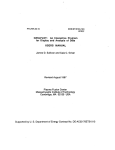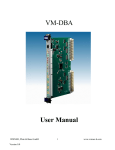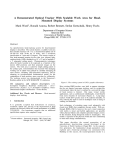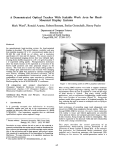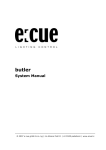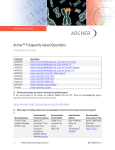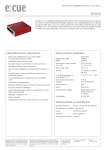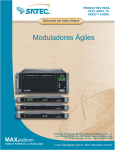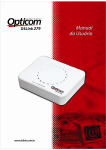Download The VMOD-TRX
Transcript
EUROPEAN ORGANIZATION FOR NUCLEAR RESEARCH ORGANISATION EUROPEENNE POUR LA RECHERCHE NUCLEAIRE CERN - PS DIVISION PS/BD Note 96-02(Tech) The VMOD-TRX: A device for communicating with remote instrumentation A. Barreira Sevillano, J.M. Belleman Abstract This module has been developed to exchange data between the VME-based control system and instrumentation in the PS accelerator and transfer line tunnels. We needed a simple data communications device, but a survey of commercially available devices showed a lack of suitable products. The VMOD-TRX is a piggy-back for use with the JANZ VMOD-IO VME module, and provides bi-directional high-speed serial data communication over up to 300m of twisted pair cable. Simple software routines to interface to user applications are described. Geneva, Switzerland May 20, 1996 Introduction To satisfy the need to exchange data with instrumentation in the PS accelerator and transfer line tunnels, we needed a simple communication device. A survey of available circuits brought to light a large void between the simple and very high performance communication links like, e.g., AMD’s TAXIchip [1], the slow but fairly complex UARTs and the very complex networking chips commonly used in computer systems. The TAXIchip is too fast to be used over twisted pairs of any significant length. UARTs are too slow and need a computer at both ends of the link. Networking chips are more complex still than UARTs. There is apparently no simple moderate-speed data link chip on the market. To meet our peculiar needs, we therefore embarked on the development of a data communications link with the following requirements: • Simple bi-directional point to point link. • No micro-processors in remote equipment. • Galvanic isolation to avoid introducing ground loops. • No opto-couplers, because they are known to fail under irradiation. • Bit serial communication at the highest practical speed over at least 300m of twisted pair cable. • Good immunity to interference. The result was dubbed the TRX. It provides high-speed point-to-point communication with equipment in remote areas. The core of the design takes the form of a list of equations to be burned into a PLD [2]. The TRX employs a serial protocol over two twisted wire pairs, sending and receiving 16 bit words at an effective rate of slightly less than 1Mbit/s. A number of mutually compatible variants exists to cope with specific types of instrumentation. One of these variants, the VMOD-TRX, described below, is designed to fit onto a VMOD-IO VME module [3]. Both receiver and transmitter are buffered with 256-word FIFOs to relieve the host processor of keeping up with the data rate proper of the TRX. Presently, the VMOD-TRX is used to communicate with the TT2 and TT70 transfer line PUs. The CODD PUs are also foreseen to be using them. D00-D15 16 FIFO 256x16 16 16 MR FE FF Serial data out MDT TXB TXRQ LB Control EN,MA0 MDT RS485 driver Manchester TS TXB TXRQ MR FE FF R D00-D15 NRZ TX MR FE FF RXB LOOPBACK E CARRIER IRQ CARRIER DETECT MR FE FF W D00-D15 16 FIFO 256x16 RS RXB 16 E CK CK RX D NRZ MDR RS485 receiver Manchester Serial data in MDR VMOD-IO MODULBUS CONNECTOR Fig. 1: Block diagram of the VMOD-TRX transceiver Nearly all the circuitry, with the exception of the FIFOs, the RS485 line interface and the Manchester decoder, is contained in a single Altera 7064 EPLD. The line interface is transformer coupled to avoid ground loops with remote equipment. 1 Theory of operation The transceiver employs an isochronous serial protocol [4]. Data is sent in frames, consisting of one or more words. A word consists of a start bit, 16 data bits (MSB first), an even parity bit and a stop bit. The transmitting sequence is started by taking /TXRQ low. /TXB goes low to indicate that the transmitter is busy. The transmit strobe, /TS, marks the instants at which new data must be applied at the parallel input port. This sequence of events is matched to the operation of the transmit FIFO, such that its current contents are sent as a single frame. CK STATE idle start D15 D14 D13 D4 D3 D2 D1 D0 parity stop start D15 D14 D13 D4 D3 D2 D1 D0 parity stop idle idle idle TXRQ TS TXB Word 1 Word 2 Frame Fig. 2: Transmitter timing diagram The data stream is Manchester modulated, which is essentially an exclusive-OR of the NRZ data with the shift register clock. This combines data and clock information into a single signal and removes DC components from the data stream, which is necessary to allow transformer coupling of the twisted pair wire interconnect. A mere exclusive-OR of clock and data would produce glitches in the Manchester code output signal. Therefore, a simple asynchronous state machine (ASM) has been used to implement this function [5,6]. This ASM takes clock and data as input, and produces a glitch-free Manchester data stream as output. It does so at the cost of one extra macrocell in the PLD and half a clock period of delay. Ck D M=0 00 Ck M=1 01 Ck Ck D Ck D D M Ck D 10 M=0 Ck 11 M=1 Fig. 3: State and timing diagrams of Manchester modulator The receiver uses an MAD85 from Data Delay Devices [7] to recover the clock and data information from the Manchester coded data stream. A synchronous state machine, driven by the recovered clock, converts the serial data back into 16 bit parallel format. Data are put into the receiver FIFO only if no parity or framing errors are detected. The detection of a single error entails the rejection of the remainder of the frame being received. The receiver treats consecutive words, i.e., words separated by only a single stop bit, as a single frame, and will signal its readiness only at the end of the frame, i.e., after detecting a second stop bit. Upon detection of a start bit, /RXB goes low to indicate that the receiver is busy. It remains low until the end of the frame. Parallel received data is available during the stop and continue states, and 2 the rising edge of /RS can be used to latch it. /RS remains high if an error was detected in the current frame. CK Serial data in STATE start idle D15 D15 D14 D14 D13 D13 D4 D4 D3 D3 D2 D2 D1 D1 D0 D0 parity parity stop start stop continue D15 D15 D14 D14 D13 D13 D4 D4 D3 D3 D2 D2 D1 D1 D0 D0 parity parity stop stop continue idle idle idle data RS RXB Word 1 Word 2 Frame Fig. 4: Receiver timing diagram When at first a connection between a transmitter and a receiver is made, and in the absence of any data transitions, the Manchester demodulator has no way of knowing the correct phase of the clock signal. As Murphy’s law predicts, it generally selects the wrong initial phase. When the first word is transferred, it drops into the right phase. This is too late to actually correctly transfer that first word. This implies that a training sequence, consisting of at least one arbitrary word, must be transmitted to force the demodulator into the correct phase. This is also the case when the loopback mode is being switched on or off. Wiring The serial line connections are brought out on the P2 connector at the rear of the VME crate [8]. Connections between transmitters and receivers are to be made using preferably screened twisted pair wire of approximately 100Ω impedance. The maximum wire length over which reliable communication can be expected is about 300m, depending on the cable quality and the induced noise levels. The pin numbers used are detailed in the table below. MODULbus is the term employed by JANZ Computer AG to denote the bus interconnecting the piggy-back modules on a VMOD-IO card. P2 pin 1a 1c 2a 2c 9a 9c 10a 10c 17a 17c 18a 18c 25a 25c 26a 26c Transmitted data (true) Transmitted data (complement) Received data (true) Received data (complement) Transmitted data (true) Transmitted data (complement) Received data (true) Received data (complement) Transmitted data (true) Transmitted data (complement) Received data (true) Received data (complement) Transmitted data (true) Transmitted data (complement) Received data (true) Received data (complement) MDT0 /MDT0 MDR0 /MDR0 MDT1 /MDT1 MDR1 /MDR1 MDT2 /MDT2 MDR2 /MDR2 MDT3 /MDT3 MDR3 /MDR3 MODULbus Socket 0 MODULbus Socket 1 MODULbus Socket 2 MODULbus Socket 3 Table A: Twisted pair wiring pin allocations on VME J2 3 Addressing Each transceiver appears in the memory space of the VMOD-IO module as two consecutive 16 bit words, the first being the data, and the second the control register. Data written into the first address is put into the transmit FIFO prior to being sent, and data received and stored in the receive FIFO can be read from it. The control register informs about and controls the state of the FIFOs and of the transmitter and receiver sections of the device. In accordance with PS/CO preferences, the base address of the first VMOD-IO in a crate is set to 0xffff6000. Further modules, if any, are situated at 0x800 intervals above that. [9] base address “ “ “ “ “ “ “ + 0x000 + 0x002 + 0x200 + 0x202 + 0x400 + 0x402 + 0x600 + 0x602 TRX 0 data TRX 0 control TRX 1 data TRX 1 control TRX 2 data TRX 2 control TRX 3 data TRX 3 control Table B: TRX addressing The control register provides information about the current state of the TRX. It also contains bits to reset the whole device, clear either FIFO, and set the loopback mode. The control register bit allocations are as follows: data control 15 14 13 12 11 10 9 8 7 6 5 4 3 2 1 0 d15 d14 d13 d12 d11 d10 d09 d08 d07 d06 d05 d04 d03 d02 d01 d00 MR LB - - TxB RxB - - Bit MR Read/ Write W LB TxFC RxFC Carrier RxERR R/W W W R R TxFF R RxFF R TxFE RxFE TxB R R R/W RxB R TxFC RxFC Carrier RxERR TxFF RxFF TxFE RxFE Description Master reset. Writing a ‘1’ into this bit clears the FIFOs, disables interrupts and disables loopback mode. It always reads back as ‘0’. Set to enable the loopback mode. Clear for normal mode. Writing a ‘1’ into this bit clears the transmit FIFO. It always reads back as ‘0’. Idem, for the receiver FIFO. True if a carrier signal is being detected. Writes are ignored. Set if the receiver detected a parity or framing error in the most recently received data frame. During write operations, this bit is ignored. Set when the transmit FIFO is full, additional data words written are discarded. Writes are ignored. Set if the receive FIFO is full, additional data received is discarded. Take note of remarks below. Writes are ignored. Set if the transmit FIFO is empty. Writes are ignored. Set if the receive FIFO is empty. Take note of remarks below. Writes are ignored. Upon read, if this bit is set, the transmitter is busy sending data. When written, it will start the transmission of data, if the transmit FIFO contains any. Set while the receiver is busy receiving data. Writes are ignored. 4 The loopback mode is intended as a way to test the transceiver. Setting the loopback mode connects the output directly to the input, bypassing the line drivers, filters and transformers. Signals from the serial data input are ignored when LB is set, but data sent is still passed to the serial data output. Setting or clearing this mode generally confuses the Manchester demodulator and a new training sequence is required. The carrier bit is derived from a detector circuit connected to the clock output of the Manchester decoder. The RxERR flag is set when a framing or parity error is detected during reception of a frame. Everything received prior to detection of the error is left in the receiver FIFO. The remainder of the erroneous frame is ignored. Parity is even. A framing error corresponds to the detection of a non-zero stop bit. The RxFE flag is updated only at each read operation from the receiver FIFO. This has the unfortunate effect that upon consultation of the control register, the receiver FIFO might seem empty, even though it does contain data. It’s only after a read attempt that the RxFE flag takes on the correct value. It is therefore necessary to issue a data read operation if one finds the FIFO flagged as empty, and then check its status again to obtain the true state of the FIFO. No data are lost because of this. The software described below is written with this in mind. A similar problem affects the RxFF flag. When the receiver FIFO is full, the RxFF flag will be set. Reading data from the receiver will not clear the flag until at least one more word is received. In this case, unfortunately, one word will be lost, because the FIFO will not accept data with RxFF set. These oddities will probably be removed in some future version of the VMOD-TRX. The TxFF and TxFE flags are not afflicted by such problems and function as might be expected. Data written into the transmit FIFO will stay there until the transmitter is explicitly started by setting the TXB bit in the control register. The whole contents of the FIFO are sent in a single frame. Data added to the FIFO while the transmitter is busy will be appended to the frame being sent. Once the transmitter has emptied the FIFO, it will halt and a new write into the TXB bit is required to start it again. Software A few simple C functions have been written to drive the TRX in the PS control environment [10]. A short description is given below: trx *trx_open(n) int n; Return a pointer associated with TRX logical channel n, to be used with subsequent calls, or NULL upon failure. void trx_close(n) Close TRX logical channel n. void putd(tp,n,data) trx *tp; int n; unsigned short *data; Send n words of the array data to TRX module referred to by the pointer tp. int getd(tp,data) trx *tp; unsigned short *data; Receive from TRX referred to by pointer tp, and put words in array data. Return number of words read. 5 void trx_putw(tp,d) trx *tp; unsigned short d; Send the single word in d to TRX referred to by tp. int trx_getw(tp,d) trx *tp; int *d; Receive one word of data from TRX tp, put it in the integer pointed to by d, and return 1 if successful, or 0 otherwise. int getstat(tp) trx *tp; Return current value of the control register of TRX referred to by tp. void putstat(tp,s) trx *tp; int s; Write the value in n into the control register of the TRX referred to by tp. int trx_rdy(tp) trx *tp; Return true if the TRX receiver referred to by tp has data available for reading. Detailed description trx *trx_open(n) int n; The function IocModulPointer() is used to obtain the hardware addresses needed to access the TRX [11]. The range of values for n normally goes from 0-3 for the first VMOD-IO, from 4-7 for the next, and so on. The correspondence between a given TRX piggy-back and a logical channel is determined by the relevant PS/CO hardware database entries. Trx_open()also resets the TRX hardware, using the MR bit in the control register. In case of problems, the return value of trx_open() is set to NULL and the return value of IocModulPointer() is copied to errno. void trx_close(n) This function takes whatever action is required to cleanly close the communication channel associated with the logical channel n. It is currently empty. void putd(tp,n,data) trx *tp; int n; unsigned short *data; n Words from the array of 16 bit words data are written into the transmit FIFO and the transmitter is activated. Putd() returns without waiting for the transmitter to terminate. It does not check if the transmit FIFO fills up. int getd(tp,data) trx *tp; unsigned short *data; This function reads all data from the receiver FIFO and puts it in the array data. The actual number of words read is returned. It is up to the caller to ensure that the array is sufficiently large. The suggested size is 256 words, equal to the length of the FIFO. If Getd() finds the receiver FIFO empty, it issues a dummy read and then checks again before returning. If the receiver is or becomes 6 active during the execution of getd(), it will return only whenever (if ever!) it manages to outrun the receiver. void trx_putw(tp,d) trx *tp; unsigned short d; Send the single 16 bit word in d to the TRX referred to by tp. The transmitter is then immediately activated. If the transmitter was already active at that time, the word is appended to the current frame. int trx_getw(tp,d) trx *tp; int *d; Read a single word from the receive FIFO of the TRX referred to by tp and put it in d. If the receive FIFO was found empty at the time of calling, a dummy read is issued, and the FIFO is checked again. The return value is the number of words read successfully, either 0 or 1. int getstat(tp) trx *tp; This function returns the current value of the control register in the 16 least significant bits of the returned integer. The bit allocations are as outlined in the paragraph describing the control register above. Note that the state bits of the receive FIFO may not reflect its actual state until a read or write operation to that FIFO has occurred. The RxFF flag is updated when the receiver state-machine puts a word into the receive FIFO. The RxFE is updated when the data register is read. void putstat(tp,s) trx *tp; int s; Write the value in n into the control register of the TRX referred to by tp. See the paragraph on the control register for the bit allocations and the effects. int trx_rdy(tp) trx *tp; Return true if the TRX receiver referred to by tp has data available for reading. Data is deemed available if the receiver FIFO is not empty and the receiver is not busy. A dummy read is issued if the receiver FIFO seems empty, and its true state is returned. Conclusion At the time of writing, ten VMOD-TRX transceivers are installed and are being used successfully to communicate with the pick ups in the TT2, TTL2 and TT70 transfer lines. However, the reliability of the transceivers suffers from the shortcomings of the VMOD-IO motherboard layout. Quite a bit of trouble was caused by the fact that there is only one ground line for each VMOD-TRX on the VMODIO motherboard. We found ourselves forced to add a crystal oscillator to each TRX, because the clock signal available from the VMOD-IO was polluted by ground bounce when the start of a VME access 7 happened to coincide with an active edge of the clock. A compatible VME module not affected by these problems is under development. Acknowledgements We are indebted to W. Heinze, who freely lent us of his precious time to sort out many implementation details. References [1] Am7968, Am 7969 data sheets, Advanced Micro Devices Inc., 901 Thompson Place, P.O. Box 3453, Sunnyvale, California 94088 [2] On dsy-xcae1, file “~jeroen/maxplus/vmod-trx/epm7064/trx.tdf” [3] VMOD-IO Hardware manual V.2.2, JANZ Computer AG, Im Dörener Feld 3, D-4790 Paderborn, Germany [4] R. Techo, “Data communications”, Plenum Press 1980, ISBN 0-306-40398-6 [5] S.H. Unger, “Asynchronous sequential switching circuits”, Wiley-Interscience, 1969, SBN 471-89632-2 [6] E.J. McCluskey, “Introduction to the theory of switching circuits”, McGraw-Hill, 1965 [7] Data Delay Devices Inc., 3 Mt. Prospect Avenue, New Jersey 07013, USA [8] VITA, VMEbus International Trade Association, “The VMEbus specification”, (IEEE/ANSI STD1014-1987, IEC821 and 297), September 11, 1987 [9] A. Gagnaire, C-H. Sicard, “Using DSCs at PS, User’s manual and cookbook”, CERN PS-CO / Note 93-082 (Spec.), Version 1.1, October 6, 1994 [10] Can be found on pspa01, filename “~jeroen/dec/trx/trx.c” [11] A. Gagnaire, “User’s manual for the DSC I/O configuration management with ‘Hardware’ ” CERN PS-CO / Note 94-055 (Spec.), Version 1.1, July 5, 1995 8











